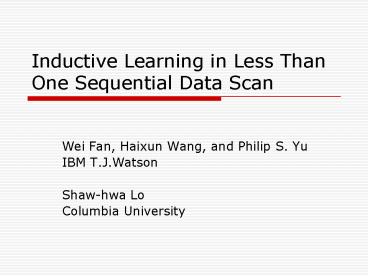Inductive Learning in Less Than One Sequential Data Scan - PowerPoint PPT Presentation
1 / 25
Title:
Inductive Learning in Less Than One Sequential Data Scan
Description:
Predict fraud since we get $10 back. Combining Multiple Models. Individual benefits ... card fraud detection. Total benefits: Recovered fraud amount minus ... – PowerPoint PPT presentation
Number of Views:47
Avg rating:3.0/5.0
Title: Inductive Learning in Less Than One Sequential Data Scan
1
Inductive Learning in Less Than One Sequential
Data Scan
- Wei Fan, Haixun Wang, and Philip S. Yu
- IBM T.J.Watson
- Shaw-hwa Lo
- Columbia University
2
Problems
- Many inductive algorithms are main memory-based.
- When the dataset is bigger than the memory, it
will "thrash". - Very low in efficiency when thrashing happens.
- For algorithms that are not memory-based,
- Do we need to see every piece of data? Probably
not. - Overfitting curve? Not practical.
3
Basic IdeaOne Scan Algorithm
Algorithm
4
Loss and Benefit
- Loss function
- Evaluate performance.
- Benefit matrix inverse of loss func
- Traditional 0-1 loss
- bx,x 1, bx,y 0
- Cost-sensitive loss
- Overhead of 90 to investigate a fraud.
- bfraud, fraud tranamt - 90.
- bfraud, nonfraud 0.
- bnonfraud, fraud -90.
- bnonfraud, nonfraud 0.
5
Probabilistic Modeling
- is the probability that x is an
instance of class -
- is the expected benefit
- Optimal decision
6
Example
- p(fraudx) 0.5 and tranamt 200
- e(fraudx) bfraud,fraudp(fraudx)
bnonfraud, fraud p(nonfraudx) - (200 90) x 0.5 (-90) x 0.5 10
- E(nonfraudx) bfraud,nonfraudp(fraudx)
bnonfraud,nonfraudp(nonfraudx) - 0 x 0.5 0 x 0.5 always 0
- Predict fraud since we get 10 back.
7
Combining Multiple Models
- Individual benefits
- Averaged benefits
- Optimal decision
8
How about accuracy
9
Do we need all K models?
- We stop learning if k (lt K) models have the same
accuracy as K models with confidence p. - Ends up scanning the dataset less than 1.
- Use statistical sampling.
10
Less than one scan
No
Algorithm
Accurate Enough?
Yes
11
Hoeffdings inequality
- Random variable within Ra-b
- After n observations, its mean value is y.
- What is its error with confidence p regardless of
the distribution?
12
When can we stop?
- Use k models
- highest expected benefit
- Hoeffdings error
- second highedt expected benefit
- Hoeffdings error
- The majority label is still with confidence p
iff
13
Less Than One Scan Algorithm
- Iterate the process on every instance from a
validation set. - Until every instance has the same prediction as
the full ensemble with confidence p.
14
Validation Set
- If we fail on one example x, we do not need to
examine on another one. - So we can keep only one example in memory at a
time. - If k base modelss prediction on x is the same as
K models. - It is very likely that k1 models will also be
the same as K models with the same confidence.
15
Validation Set
- At anytime, we only need to keep one data item x
from the validation set. - It is sequentially read from the validation set.
- The validation set is read only once.
- What can be a validation set?
- The training set itself
- A separate holdout set.
16
Amount of Data Scan
- Training Set at most one
- Validation Set once.
- Using training as validation set
- Once we decide to train model from a batch, we do
not use it for validation again. - How much is used to train model? Less than one.
17
Experiments
- Donation Dataset
- Total benefits donated charity minus overhead to
send solicitations.
18
Experiment Setup
- Inductive learners
- C4.5
- RIPPER
- NB
- Number of base models
- 8,16,32,64,128,256
- Reports their average
19
Baseline Results (with C4.5)
- Single model 13292.7
- Complete One Scan 14702.9
- The average of 8,16,32,64,128,256
- We are actually 1410 higher than the single
model.
20
Less-than-one scan (with C4.5)
- Full one scan 14702
- Less-than-one scan 14828
- Actually a little higher, 126.
- How much data scanned with 99.7 confidence?
- 71
21
Other datasets
- Credit card fraud detection
- Total benefits
- Recovered fraud amount minus overhead of
investigation
22
Results
- Baseline single 733980 (with curtailed
probability) - One scan ensemble 804964
- Less than one scan 804914
- Data scan amount 64
23
Smoothing effect.
24
Related Work
- Ensenbles
- Meta-learning (Chan and Stolfo) 2 scans
- Bagging (Breiman) and AdaBoost (Freund and
Schapire) multiple - Use of Hoeffdings inequality
- Aggregate query (Hellerstein et al)
- Streaming decision tree (Hulten and Domingos)
- Single decision tree, less than one scan
- Scalable decision tree
- SPRINT (Shafer et al) multiple scans
- BOAT (Gehrke et al) 2 scans
25
Conclusion
- Both one scan and less than one scan have
accuracy either similar or higher than the single
model. - Less than one scan uses approximately 60 90
of data for training with loss of accuracy.































